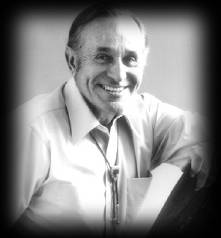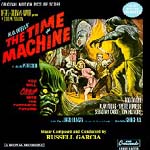The Time Machine
- Russell Garcia
In 1960's The Time Machine (D: George Pal),
George (H.G. Wells played by Rod Taylor) is a self-described "tinkering
mechanic" in 1899 London. He builds a time machine to travel to the
distant future (802,701 A.D.!) where the Morlocks, a cannibalistic race
of loathsome mutants who live underground, threaten the Eloi, the mild
gentle race living on the earth's surface. George meets and falls in
love with a beautiful Eloi, Weena (Yvette Mimieux). When his time machine
is stolen by the Morlocks, George must risk capture himself in order
to save Weena and the Eloi and rescue the time machine. When he is forced
to return to his own time, he decides to go "back to the future" and
Weena. The Time Machine, scored by "unsung Hollywood legend" Russell
Garcia, did not have a soundtack album release when the film first appeared.
Following destruction of the score's parts by the production studio
(MGM, boo!), Garcia reconstructed the score from conductor sketches
that fortunately still were available, making possible a re-recording
of the score and the release of a soundtrack CD (GNP/Crescendo GNPD
8008).
A sample of the CD's cues conveys the richness of Garcia's score as
well as the film's plot: "London 1900," "The Time Machine," "Quick Trip
Into The Future," "Weena (Love Theme)," "Fight With the Morlocks," "Time
Traveler," "Trapped In The Future," and "Love And Time Return." In scoring
The Time Machine, Garcia employed an innovative technique--collecting
taped sounds (percussion instruments, gongs, temple blocks, a saw struck
with a soft mallet, a table knife vibrating, crinkling cellophane paper,
and even a straw blown through gelatin); running the sounds through
feedback echoes, backwards and at different speeds; and then writing
the sounds into the score as if they were instruments, adding the sounds
to the recorded orchestral score in the dubbing session. Although taking
an unconventional approach to his scoring assignment, the final product
was a romantic score that is rich in melody, expressing human emotions
ranging from fear to love.
In
a 1987 interview, Garcia discussed receiving the script from the film's
director, George Pal, who asked:"'Russ, could you bring me a few themes
after you read the script?' So I thought, 'Well, it goes into the future.
I can write some quite dissonant, modern music.' So I did, and played
some of these things for George, and he said, 'Oh, very nice, Russ,'
but he wasn't too enthusiastic. I went home and wrote down some simpler
folk-type themes. I played these for him and he was all happy and all
smiles. When it actually came to doing the film I used both, some of
the folk-type things and also some of the more dissonant, modern things,
because when you hear it with the film it fits."
(Matthias Bodinger, Soundtrack!, Vol. 6/No. 23, September 1987,p.26)
|

